Feature Articles - The Easter Rising, Dublin 1916
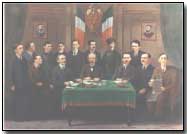
Background and Long-Term Causes
The English occupation of Ireland, which began in 1169, had always been resisted fiercely throughout the centuries. The many rebellions and wars had always been defeated. Following the failed 1798 rebellion the English imposed on Ireland, in 1801, what they called "The Act of Union". This annexed Ireland as part of the United Kingdom of England, Ireland, Scotland and Wales. The English continued to dictate matters and forbade Irish Catholics from becoming members of their parliament.
In 1829 Daniel O'Connell gained Catholic Emancipation for the Irish. This meant in theory that Irish Catholics could enter parliament. However in practice this helped the Irish little as there was no secret ballot and a man was usually obliged by his Anglo-Irish (Person of English descent generally Protestant) Landlord to vote for him or someone he favoured.
When the secret ballot act was introduced things began to change in Ireland. A Home Rule party was established and the great estates of the Anglo-Irish were forcibly sold to the people that lived on them. A Dublin parliament was campaigned for tirelessly by Parnell and his many followers however it was continually defeated by the British House of Lords (Lower House of the London Parliament which consisted of hereditary Lords, i.e. not voted in by the people).
Unfortunately for Irish politicians their inspired leader Charles Stewart Parnell fell into disrepute as a result of him marrying a divorcee, Kitty O'Shay. The Home Rule party split over the issue and was weakened significantly as a result.
Resentment against the British began to show a violent side again with the Irish Republican Brotherhood secretly plotting against the British. A Gaelic revival began in the 1880s with the establishment of the Gaelic Athletic Association in 1884 and various other organisations thereafter. The formation of the Republican political party Sinn Féin (Ourselves Alone) in 1905 was further evidence of anti-British sentiment growing in Ireland. Further dissatisfaction came to the surface in 1913 with a general strike in Dublin.
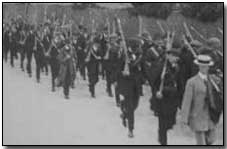 Parallel to this, opposition to
Home Rule was growing within Ireland itself (in the protestant dominated
north-east) in the form of Unionism. Northern Protestants were worried about
losing their privileged position in society, and scared of an independent
Ireland. While the Unionist, Ulster Volunteer Force imported arms illegally and
unopposed by the law, the Nationalist Irish Volunteers were harassed by the law. (The British Army shot dead several people in Dublin after being jeered at by
locals).
Parallel to this, opposition to
Home Rule was growing within Ireland itself (in the protestant dominated
north-east) in the form of Unionism. Northern Protestants were worried about
losing their privileged position in society, and scared of an independent
Ireland. While the Unionist, Ulster Volunteer Force imported arms illegally and
unopposed by the law, the Nationalist Irish Volunteers were harassed by the law. (The British Army shot dead several people in Dublin after being jeered at by
locals).
Home Rule was to be introduced in 1914 but was put-off because of World War One. Hundreds of thousands of young Irish Volunteers were sent off to the trenches to fight, misguided in the belief that Ireland would be peacefully granted Home Rule by their leader John Redmond. (Over 50,000 young Irishmen died in the trenches).
The position for the IRB and Irish Volunteers - Autumn 1914
By the summer of 1914 it is clear that the extreme elements of Irish Nationalism were now determined to hold a rebellion. This started with the meeting between a group of Clan na nGael and the German ambassador in the USA.
A meeting for September 1914 of the "Physical Force" men was organized by Thomas Clarke. All seven future signatories of the 1916 proclamation were present. It was agreed that they would: make contact with Germany for military assistance; Plan for a Dublin Rising; and increase the size of the now severely decimated (as a result of going to France to fight) Irish Volunteers and the Irish Citizen Army (A far smaller force set-up in 1913 to protect the strikers during the lockout).
With such a small force (c.12,000) it seems impossible that the IRB (Irish republican Brotherhood) thought they could beat the British in open rebellion. However, the planning continued. In December the Irish Volunteers published a "Scheme of Military Organisation for the Volunteers" which detailed their structure and policy.
Planning a Rising - 1914-December 1915
By 1914 Roger Casement's (a recently retired Diplomat and also an Irish nationalist) sympathies were firmly with Germany. At this time he was in America while John Devoy had been contacting the German diplomats.
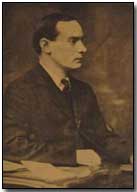 It was decided that Casement would be sent to
Germany for the purpose of procuring arms and to attempt to raise an Irish Brigade
from Prisoners of War captured by the Germans. He obtained a formal statement of
support from the German Authorities. This contained a pledge to keep Ireland
free in the event of a German victory.
It was decided that Casement would be sent to
Germany for the purpose of procuring arms and to attempt to raise an Irish Brigade
from Prisoners of War captured by the Germans. He obtained a formal statement of
support from the German Authorities. This contained a pledge to keep Ireland
free in the event of a German victory.
He failed to raise an Irish Brigade and his movements were already being monitored by the British. Although this mission ultimately failed, it kept an open door between the two peoples and eventually led to arms being sent (though sunk).
In the early months of 1915 lectures on street fighting among other things, were given by James Connolly, Thomas MacDonagh, and others to the Irish Volunteers. Pearse was made a Commandant, as were James Plunkett, Bulmer Hobson, Thomas MacDonagh, Eamon Ceannt, Eamon De Valera and Edward Daly.
In March, the seven IRB Commandants met (this was not an Irish Volunteer meeting) to discuss a possible rising in September. A military council was also set-up by the IRB in May of that year. One of the reasons why this rising did not go ahead was possibly due to Seán MacDiarmada's (Seán MacDermot) imprisonment for three months due to speaking against British Army recruitment. Not enough arms had been landed, a crucial factor for success.
On 1st August 1915 Jeremiah O' Donovan Rossa, a veteran Fenian (predecessors of the IRB) was buried having died in New York. The body, which had been brought to Dublin, and the subsequent funeral proved a massive propaganda coup for the IRB.
A large turn out of the IRB, Irish Volunteers, and the Citizen Army showed their solidarity. Pearse made his famous graveside oration which contained the words "They have left us our Fenian dead (referring the the Fenians killed by the English)... Ireland unfree shall never be at peace." This set the mood for the next 6 years and perhaps until the present day.
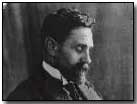 An unlikely danger came from
James Connolly after he had been too open about his rebellion beliefs. Action
had to be taken against him which also highlighted the need for urgency. It
could only be a matter of time before the plans were uncovered by the British
authorities, so the IRB decided it must act or face the possibility of being
arrested. Time was by now not on their side.
An unlikely danger came from
James Connolly after he had been too open about his rebellion beliefs. Action
had to be taken against him which also highlighted the need for urgency. It
could only be a matter of time before the plans were uncovered by the British
authorities, so the IRB decided it must act or face the possibility of being
arrested. Time was by now not on their side.
As 1916 neared final plans for a rebellion were made by the IRB. Easter 1916 was set as the date with Connolly in total cooperation with the planners. They all agreed that a rebellion would have to occur before the end of the war for maximum military effect. All this time Eoin MacNeill (the head of the Irish Volunteers, not an IRB member, and unaware of the IRB's plans for a rising) had been purposely kept in the dark.
Getting Arms for the Rebellion - January-Good Friday 1916
The big problem of getting enough arms for a rebellion prevailed into 1916, and henceforth plans were organized by John Devoy.
The Germans were completely against the notion of sending a military force but cooperated with the arms problems. 20,000 rifles with ammunition were to be sent in April, but the British authorities had broken the German codes and were expecting something to happen. But no decisive action was taken by the British Forces.
The arms left the German port of Lübeck on 9th April bound for landing on the Kerry coast (the south-west of Ireland). But by now, however, Casement was disillusioned with the notion of a rising and anxiously left on a submarine with the firm intention of halting it.
Things began to go horribly wrong when the Aud, the German ship disguised as a Norwegian merchantman put in at the wrong port. At this critical moment the British were by now scanning the horizons searching for her.
On Friday while waiting in Tralee Bay the elusive Aud was captured at gunpoint by the British Navy. When she reached Cork harbour the German Captain, who was still in command, scuttled her and the arms were lost, as well as any hope of an Irish military success. To the British, now a rising seemed impossible. Things seemed to have gone completely their way.
Final Plans for the Rising
 An article published in
The
Irish Volunteer on the 8th April called for manoeuvres on Easter Sunday (the
23rd).
An article published in
The
Irish Volunteer on the 8th April called for manoeuvres on Easter Sunday (the
23rd).
Eoin MacNeill was still unaware that the manoeuvres were in fact to be a uprising. The famous "Castle Document", a forged note purporting that the leaders of the Volunteers were to be arrested by the British, the organisation disarmed, and Dublin to be occupied by the British Army was in fact a forgery and was "planted" on Eoin MacNeill.
He was informed of the planned landing of arms and he issued an order to take part in a "defensive war". He was not informed that the Aud was captured but on Saturday discovered the forgery, and issued a countermanding order. By now the Authorities in the Castle were in confusion because of the many rumours going around.
The seven main leaders spent Easter Sunday deliberating on a decision for a rising on Monday. Although it was obviously hopeless they came to a decision and Pádraic Pearse issued an order at 8pm. The rising would go ahead.
Blood Sacrifice - Easter Week 1916 - The Rising
At about noon on Easter Monday, 24th April 1916, elements of the Irish Volunteers began to assemble. MacNeill's countermanding order had meant that most did not turn up. The officers desperately tried to rally more men but only a pitiful 1,600 out of 10,000 (including the 200 Citizen Army) turned up.
The plan was to take the city by holding a defensive crescent of strong-points on each side of the city. The headquarters would be the General Post Office (GPO). The rest of the country was expected to rise in support of the Dublin rebellion and reinforce it if necessary.
A withdrawal to Tyrone (160km to the north) and a guerrilla-style war was to be waged if things did not go well in Dublin. Even with 10,000 turning out this plan seemed quite optimistic, but in the present situation things could not succeed militarily.
Pádraig Pearse said himself: "There are many more things more horrible than bloodshed and slavery is one of them".
The Captured Buildings - Who and Where
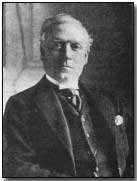 The defence of Rebel-held
Dublin depended on this crescent line of strong-points with the GPO on O'Connell
Street as its headquarters.
The defence of Rebel-held
Dublin depended on this crescent line of strong-points with the GPO on O'Connell
Street as its headquarters.
The principal buildings captured by the rebels were:
The Four Courts (Commandant Edward Daly's 1st Battalion); the Jacob's Factory in Bishop Street (Commandant Thomas MacDonagh's 2nd Battalion); Boland's Mills on the Grand Canal (Commandant Éamonn DeValera's 3rd Battalion) and the South Dublin Union Workhouse (Éamonn Ceantt's 4th Battalion). St. Stephen's Green and the College of Surgeons was captured by Commandant Michael Mallin's part of the Irish Citizen Army.
Among the other building's captured was the Mendicity Institution (Captain Seán Heuston with a small party of men). The area around Mount Street Bridge over the Grand Canal was captured by men from Commandant DeValera's Battalion. Other buildings captured were: Carisbrook House (Now the Israeli Embassy in Ballsbridge); Buildings on Church Street and North King Street; J and T Davy's Public House on Portobello Bridge (Now the Portobello Public House; City Hall; Hopkins and Hopkins, on the corner of O'Connell Street & Eden Quay (Now a branch of the Irish Nationwide Building Society); the corner of O'Connell Bridge and Bachelors Walk (the building with the big Baileys Irish Cream advertisement); A Wireless School on the south corner of Lower Abbey Street (Now AIB Bank); Clery's and the Imperial Hotel (Clery's now occupies the whole building).
Buildings on North Earl Street including Tyler's Shoe Shop (Now Café Kylemore); the Metropole Hotel on O'Connell Street (Now Pennys clothes shop); No. 16 Moore St; Westland Row railway station (Now Pearse Station); and Broadstone Railway Terminus.
The First Shots are fired - Noon
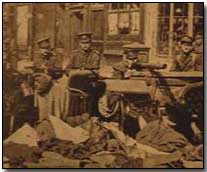 The signal for the commencement
of the rising was supposed to have been quite spectacular.
The signal for the commencement
of the rising was supposed to have been quite spectacular.
The Magazine Fort, a large store of explosives owned the British Army in the Phoenix Park, was to have been blown up by a small party under the command of Gary Holohan.
They broke in but failed to gain access to the main store (as the key was missing) and attempted to blow it up. It failed to explode the whole store.
A party of the Irish Citizen Army under the command of Captain Seán Connolly at noon proceeded to Dublin Castle with orders to attack the castle. A policeman appeared and was shot.
They failed to capture the Castle (it turned out they could easily have done so as it was under manned) and withdrew to City Hall. The GPO was captured without much grief around the same time and the proclamation of the Irish Republic was read out by Pádraig Pearse, President of the Provisional Government:
THE PROCLAMATION OF POBLACHT NA h'ÉIREANN
THE PROVISIONAL GOVERNMENT OF THE IRISH REPUBLIC TO THE PEOPLE OF IRELAND
IRISHMEN AND IRISHWOMEN: In the name of God and of the dead generations from which she receives her old tradition of nationhood, Ireland, through us, summons her children to her flag and strikes for her freedom.
Having organised and trained her manhood through her secret revolutionary organisation, the Irish Republican Brotherhood, and through her open military organisations, the Irish Volunteers and the Irish Citizen Army, having patiently perfected her discipline, having resolutely waited for the right moment to reveal itself, she now seizes that moment, and, supported by her exiled children in America and by gallant allies in Europe, but relying in the first on her own strength, she strikes in full confidence of victory.
We declare the right of the people of Ireland to the ownership of Ireland, and to the unfettered control of Irish destinies, to be sovereign and indefeasible. The long usurpation of that right by a foreign people and government has not extinguished the right, nor can it ever be extinguished except by the destruction of the Irish people. In every generation the Irish people have asserted their right to national freedom and sovereignty; six times during the last three hundred years they have asserted it to arms. Standing on that fundamental right and again asserting it in arms in the face of the world, we hereby proclaim the Irish Republic as a Sovereign Independent State, and we pledge our lives and the lives of our comrades-in-arms to the cause of its freedom, of its welfare, and of its exaltation among the nations.
The Irish Republic is entitled to, and hereby claims, the allegiance of every Irishman and Irishwoman. The Republic guarantees religious and civil liberty, equal rights and equal opportunities to all its citizens, and declares its resolve to pursue the happiness and prosperity of the whole nation and all of its parts, cherishing all of the children of the nation equally and oblivious of the differences carefully fostered by an alien government, which have divided a minority from the majority in the past.
Until our arms have brought the opportune moment for the establishment of a permanent National, representative of the whole people of Ireland and elected by the suffrages of all her men and women, the Provisional Government, hereby constituted, will administer the civil and military affairs of the Republic in trust for the people.
We place the cause of the Irish Republic under the protection of the Most High God whose blessing we invoke upon our arms, and we pray that no one who serves that cause will dishonour it by cowardice, in humanity, or rapine. In this supreme hour the Irish nation must, by its valour and discipline and by the readiness of its children to sacrifice themselves for the common good, prove itself worthy of the august destiny to which it is called.
Signed on Behalf of the Provisional Government.
Thomas J. Clarke,
Sean Mac Diarmada, Thomas MacDonagh,
P. H. Pearse, Eamonn Ceannt,
James Connolly, Joseph Plunkett
To the bemusement of Dubliners passing-by on their holiday this was posted up all over the city. As this was happening, all over the city men were occupying buildings in the name of this Irish Republic.
The Course of the Week
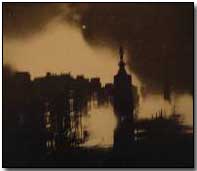 To the British Forces in Dublin
the rising came as quite a shock. They were confident that with only a limited
supply of arms the rebels would not rise, and on Easter Monday most were away
enjoying a day out at the races.
To the British Forces in Dublin
the rising came as quite a shock. They were confident that with only a limited
supply of arms the rebels would not rise, and on Easter Monday most were away
enjoying a day out at the races.
The first British incursion into Rebel-held territory was one of some antiquity. A group of lancers (mounted soldiers) rode up O'Connell Street and were cut down by firing from the GPO. With this small success the rebels went about their work preparing their defences with some confidence.
Rumours abounded the city of a German landing, and a mass rising in the rest of Ireland. However, these rumours were nearly all untrue. The question was now: How long could they hold out? By Monday evening British reinforcements were pouring in from all over Ireland and preparations were being made in England for sending many more over. General Lowe took charge of the British and Martial Law was declared.
The IRB had not anticipated that the British would use artillery to attack. They preferred to think that there would be cavalry charges and street fighting. The lack of sufficient arms proved also to be a vital factor and it was reported that some men were using pikes.
Dublin was surrounded quickly and by Thursday 12,000 British had arrived. The rebels had not one machine gun. All they could do now was to sit and wait for the attack and it did come.
On Wednesday the bloodiest battle of the whole week was in progress. A party of seventeen men in houses on Northumberland Road and overlooking Mount Street Bridge faced a whole battalion of the British Army (700-800 men).
The British used tactics from the trenches to try and get through and casualties were massive. After 8 hours of charges the British had lost 230 killed and wounded. Most of the seventeen Irish escaped with their lives. In support of their infantry attacks the British brought a gun ship, the Helga, up the River Liffey and it bombarded the rebel positions.
By Thursday the British had over 12,000 soldiers in Dublin. A cordon had been established to isolate the rebel positions. They began to edge closer in on the volunteers. On Friday the GPO had to be evacuated because the roof and much of the building was burning as a result of artillery bombardment.
Much of O'Connell Street was also burning by now and the street was a death trap to any volunteer that ventured out because of the machine gun bullets filling it. The end was in sight for the rebels.
At noon on Saturday 29th April 1916, decided that to avoid further deaths of civilians they must surrender. At 3.30pm Pearse handed General Lowe his sword and wrote the surrender order.
Elsewhere things in Ireland did not go as planned. In Ashbourne, Co. Meath, a party of volunteers fought and won a battle with the RIC (Royal Irish Constabulary); in Galway several hundred wandered until they were dispersed by a British ship which fired at them; in Cork they turned out but then went home; in Enniscorthy they captured the town and set up camp on vinegar hill (as in 1798) but later dispersed.
Elsewhere little happened. Some men made it to Dublin but had little consequence.
Casualties
64 Rebels Killed, 120 Wounded
British Army and Police 132 Killed, 397 Wounded
Civilians 300 Killed, 2,000 Wounded
The Aftermath
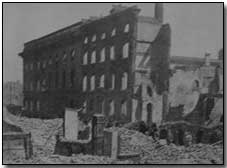 The immediate feeling in Dublin
after the rising was of indignation. The rebels were jeered at and pelted with
rotten fruit by civilians. Much of the centre of Dublin had been all but
destroyed. 300 Civilians had been killed and martial law remained in force.
The immediate feeling in Dublin
after the rising was of indignation. The rebels were jeered at and pelted with
rotten fruit by civilians. Much of the centre of Dublin had been all but
destroyed. 300 Civilians had been killed and martial law remained in force.
Initially 3,000 men were arrested but half were released. 1,800 were imprisoned in Britain and 100 were sentenced to death. The executions began on 3rd May and continued until the 12th. General Maxwell, now the British commander, refused to listen to anyone and 15 were shot by the time he had stopped them as a result of the sway in public outrage towards the executions.
A great change in public opinion occurred and by June most showed sympathy towards the rebels cause. There was much anti-Britishness and many felt that the rising had been the fault of the British. Another reason was because of British atrocities against civilians during and after the rising. People now viewed the rising as a clean fight (on the part of the rebels) worthy of the glory shown by them.
The Easter Rising had a profound effect on the course of Irish history. The War of Independence of 1919-21 grew out of it. By 1918 the republican cause was the dominant one in Ireland and the Irish Volunteers were ready to fight for their country if the British continued to refuse Irish Independence.
The Dáil (Irish Parliament) was formed on 21st January 1919 and independence was declared.
Article contributed by (and copyright to) DublinTourist.com
'White Star' was a German mixture of chlorine and phosgene gas, so-named on account of the identification marking painted on the delivery shell casing.
- Did you know?
